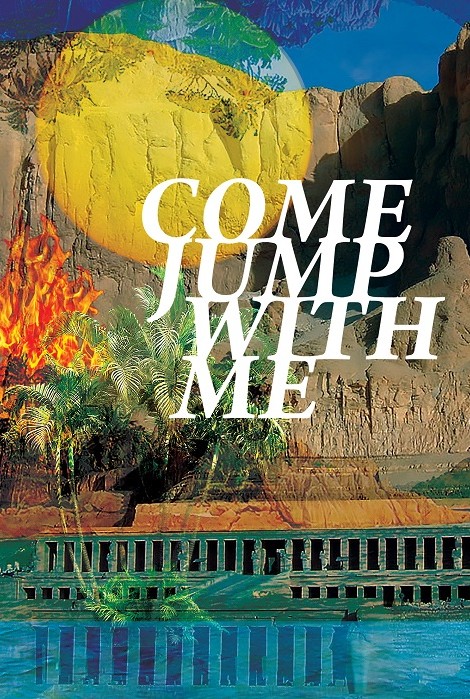Come Jump With Me
29/11/2015
The name of Yossi Berg and Oded Graf’s new work, Come Jump With Me, references a similar work by Pina Bausch: “Come Dance With Me” (in German). Both invitations – to dance and to jump (into the water? Off the roof?) – are neither innocent nor ingenious. In both works the call for action stems from distress (Berg) and partly from bullying (Bausch).
Berg and Graf belong to the group of artists that one might define as the “middle generation,” artists who came from Dance, moved forward, yet have not cut the umbilical Dance cord, whose definition has expanded. Their work is comprised of clear theatrical components, narrative components, and includes a dialogue between artists.
Clearly they decided to hone the production’s bull’s-eye political messages, which are targeted relentlessly and with in-your-face clarity. Is this the Holy Land that we dreamed about for generations? Berg and Olivia Court Mesa speak English with accents. The decision to use a foreign language distances the text from the here-and-now and allows for a certain amount of freedom that is not always accessible in the local language (not to mention the fact that Hebrew is not Court Mesa’s native tongue). Use of a foreign language also facilitates the formation of a few fundamental phrases that are repeated in different ways, with evolving intonations that disguise the directness, i.e. the simplicity of each sentence. Thus sequences of everyday words take on depth as they are repeated in different contexts and tones. There are several such examples throughout the performance.
With Come Jump With Me, Berg and Graf have perfected the dance-theatre style that characterizes their work, in which humor and childlikeness enjoy a place of honor. Berg’s physical appearance seemingly has not changed since he was a teenager: a slim body, long limbs and the smile of a precocious 13 year-old. He and Court Mesa work wonderfully together, despite being very different. Both are strong dancers with a robust stage presence. They both manage their bodies as sophisticated tools accessible in any situation, without making an effort to be cute or pretty, as can be seen as they jump rope more than 100 times without stopping their conversation!!
“So this is the Holy Land?” asks Berg. Sitting on chairs, both ask and then answer questions – but not to each other. This culture of dialogue is familiar to us and is one that our politicians, more than anyone else, are excel at. Clichés next to sad reflections in a place that does not differentiate between the two. The social-political messages are sharp as a scalpel. So why are we laughing?
Berg recounts that he did not serve in the military; perhaps because he came out of the closet when he was 18 (a fact he also shares with us as part of a concise biography conveyed on the stage). The irony, he tells us, is that as fate would have it he played a soldier in Ohad Naharin’s Kyr/Zina when he danced with the Batsheva Dance Company. Again he played a soldier when he danced with DV8, and yet again when he danced in Yasmeen Godder’s Strawberry Cream and Gunpowder and in his own Animal Lost. In Come Jump With Me he once again dances as a soldier, as he most likely will again in who-knows-how-many future productions. In motions and movements he positions himself as if he is about to shoot, and then grabs Court Mesa by the waist, holding her on his hip as if she were a missile. It is objectifying, precise and also distressing in so many ways.
In one scene, which is especially touching and interesting, Berg relies solely on his body to communicate a complex message. He and Court Mesa bend down and take into their hands a virtual item the size of a fist, which they throw in different directions, over the heads of the audience. They then recoil from what is clearly the imaginary blast of a hand grenade. They then dodge as the same weapon (or perhaps stone?) is thrown back at them. One presumes that there are those who will insist this is game of dodge ball, or that the sentence “We love Israel!” is a deduction or perhaps a shout of approval. However, one must note that the sentence was perceived by most of the audience as sarcastic and funny, which is not surprising.
Nevertheless, Berg does not leave us with an unpleasant taste in our mouths. Not at all. Court Mesa covers the stage with piles of red lollipops, which serve to help sweeten the bitter pill. Berg grabs a blue-and-white oar and sits down. Court Mesa sits behind him and the two happily sail off into the horizon. This concluding image is a bit confusing. Are we talking about a positive (pink) future? If so, is it beyond the non-existent political horizon, or beyond the ocean by way of Berlin?
Will Minister of Culture Miri Regev shed a tear in mourning?
In the end, this performance throws at us thousands of questions and very few answers. Coincidentally, over the past few months many new works have been produced that also focus on the ongoing political and security situation in Israel. After many years during which dance artists distanced themselves from political messages that weren’t in code or subtext, the dam has broken.
If the bursting dam will also impact the audience, perhaps all of us will find a horizon to hold on to. Otherwise, where are we going? In that case the meaning of Come Jump With Me can only be bleak.
– Ora Brafman, Dance Talk
